An Ark for Amphibians
The quest to find climate-safe habitats for endangered creatures
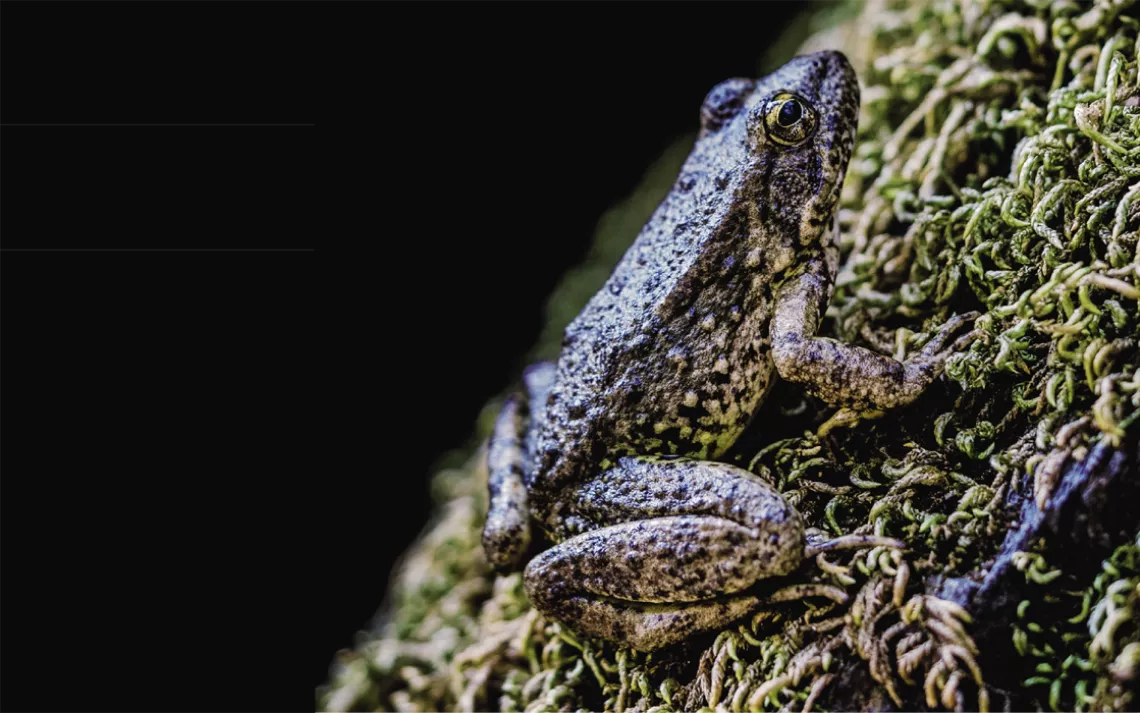
An adult foothill yellow-legged frog at Robbers Ravine in Colfax, CA.
THE FOOTHILL YELLOW-LEGGED FROG is a slippery creature about the size of a silver dollar, with topaz eyes and neon-yellow splotches on the underside of its meaty legs. During the approximately 6 to 9 million years of its existence, the amphibian has stood sentinel to change in the Sierra Nevada. It watched as glaciers encrusted its habitat in ice and then retreated. When European settlers blasted away riverbeds in search of gold, the frog hung on deep in the rocks and crevices of tiny streams. It persisted even as dams corralled its waterways.
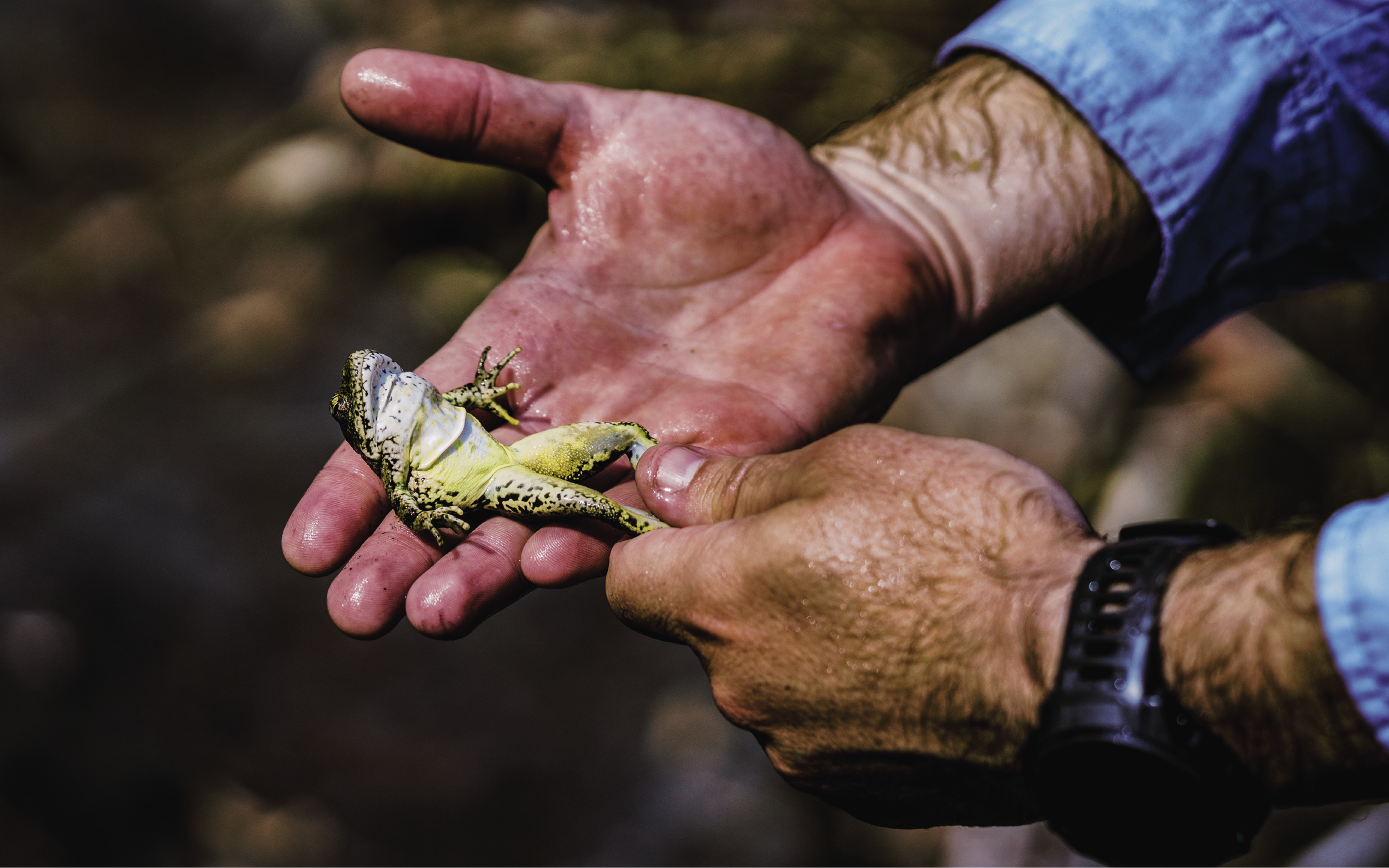 An adult foothill yellow-legged frog.
An adult foothill yellow-legged frog.
"You list all these things, and they're still here," said Ryan Peek, an ecologist at the University of California, Davis. "They are amazingly resilient."
Global warming could change that for good.
On a scorching-hot morning in mid-August 2021, Peek and I crouched in the steep, oak-shaded Robbers Ravine. Air tankers circled overhead as they prepared to drop fire retardant on the nearby River Fire. Nestled in the gully were a series of deep tubs carved into the bedrock over time by rushing water. The creek through the ravine traces a path to the North Fork of the American River, which in turn rushes to the Folsom Reservoir and on to Sacramento. That day, the pool into which we stared was empty. Other pools contained shallow, murky water or slurries of green algae. "This is crazy," Peek said.
Fifty years ago, foothill yellow-legged frogs crowded the banks of streams throughout much of California. Scientists describe how it used to be difficult to take a single step without squishing a frog beneath your foot. "They were just like popcorn," Peek said. But in the second half of the 20th century, the frogs began to disappear. Non-native bullfrogs invaded their habitats and ate them. Chytrid fungus—the source of chytridiomycosis, a deadly disease implicated in the extinction of 90 amphibian species—swept through some watersheds in Southern California, killing off the frogs. Then, in late 2011, California entered its most severe drought in as many as 1,200 years. Tributaries like Robbers Ravine dried up, crowding the frogs into shallow pools. This created the perfect conditions for the fungus to spread. The frogs became an easy feast for predators.
Foothill yellow-legged frogs have disappeared from half their former range, and the population is declining fast. "Knowing that some of these places may not have frogs when my kids are adults sucks," Peek said. "It's not a great outlook." In 2019, thanks to Peek's graduate dissertation on the species, five of the six subpopulations of foothill yellow-legged frogs in California were listed as endangered.
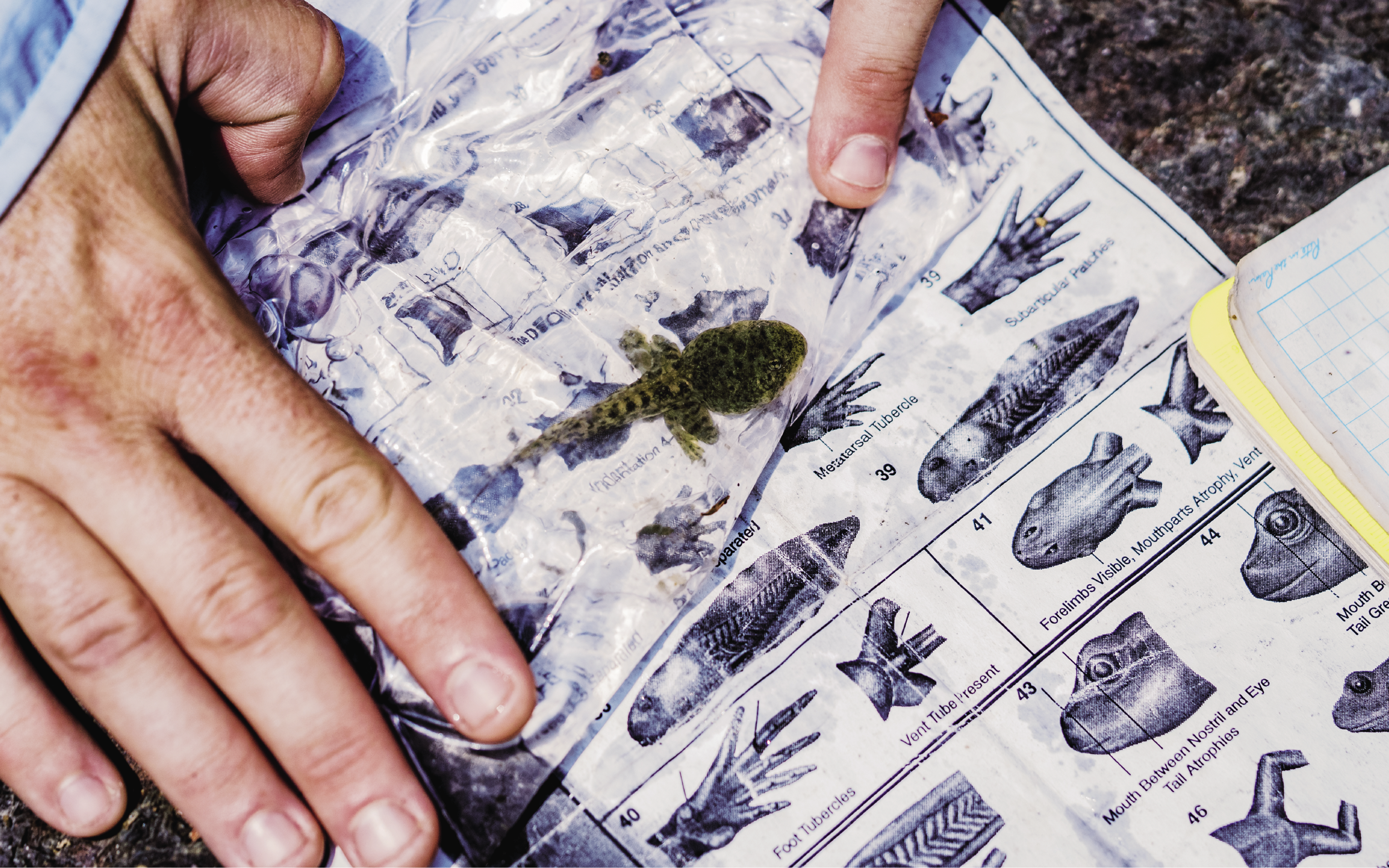 Ryan Peek, an ecologist at UC Davis, examines a tadpole at Robbers Ravine in Colfax, CA.
Ryan Peek, an ecologist at UC Davis, examines a tadpole at Robbers Ravine in Colfax, CA.
Heading toward the top of the ravine, we reached an oasis—an unexpectedly lush pool fed by groundwater. "This is my spot," Peek said. Despite the apparent lack of water in Robbers Ravine, the place was peppered with frogs. They leaped off the steep walls of the gully. Beady eyes peeked up at us from the remaining puddles.
It's the prospect of oases that gives Peek and other scientists hope, for not just the foothill yellow-legged frog but also myriad other species, from New England's red squirrels to Oregon's elk. Climate change doesn't spread its effects evenly over the landscape. While some locales are pummeled by extreme weather year after year, others remain curiously unaffected. These places remain cooler than the surrounding landscape, and quirks of geology buffer them from the effects of global warming. Scientists call these safe havens climate refugia. They hope these pockets in the landscape will provide plants and animals an ark in which to ride out the worst effects of climate change, until conditions become favorable once more.
But first, scientists have to find the refugia and protect them—and get the plants and animals there in a process of assisted migration. A coalition of scientists, conservationists, and land managers in California are beginning that process for many species, including the pika, the Torrey pine, and a certain frog with splotches of neon yellow on its legs.
LONG BEFORE HUMANS heated up the atmosphere with greenhouse gases, shifts in climate shaped the course of life on Earth. Over the past 2.6 million years, roughly 30 percent of Earth's surface became encrusted in ice, then thawed, then froze again—around 20 times. Just about all species on Earth were shaped by these cycles. Many wouldn't exist if their ancestors hadn't found refugia.
The term climate refugia emerged from paleoecology, the study of how plants and animals interact with their environment and one another over time. For hundreds of years, scientists have debated the reason for the incredible diversity of species on Earth. Why, for example, do we see 18 species of macaw in the Amazon rainforest instead of just one? While Darwin's theory of evolution supplied a broad intellectual framework for speciation, it left many of the details unanswered. In the 1960s, some researchers proposed refugia as a possible answer. They hypothesized that during ice ages, species had escaped to pockets that remained hospitable. In refugia, plants and animals continued to thrive until the climate warmed once more and they were able to fan out across the landscape again. These periods of isolation allowed plant and animal populations to evolve separately, until they were no longer the same species. The role of refugia in these species' survival is written into their genes.
Around the turn of the millennium, climate refugia began to be used in the context of climate change wrought by humans. As scientists began warning the public about global warming, some also started to wonder where plants and animals might have the best shot at survival. But they had no way of precisely projecting into the future, said Carlos Carroll, an ecologist at the Klamath Center for Conservation Research. In the early 2000s, researchers got a new chest of tools: computer programs that could analyze myriad variables about the environment, from topography to soil composition, and better calculate the future of the climate in a particular region in more granular detail.
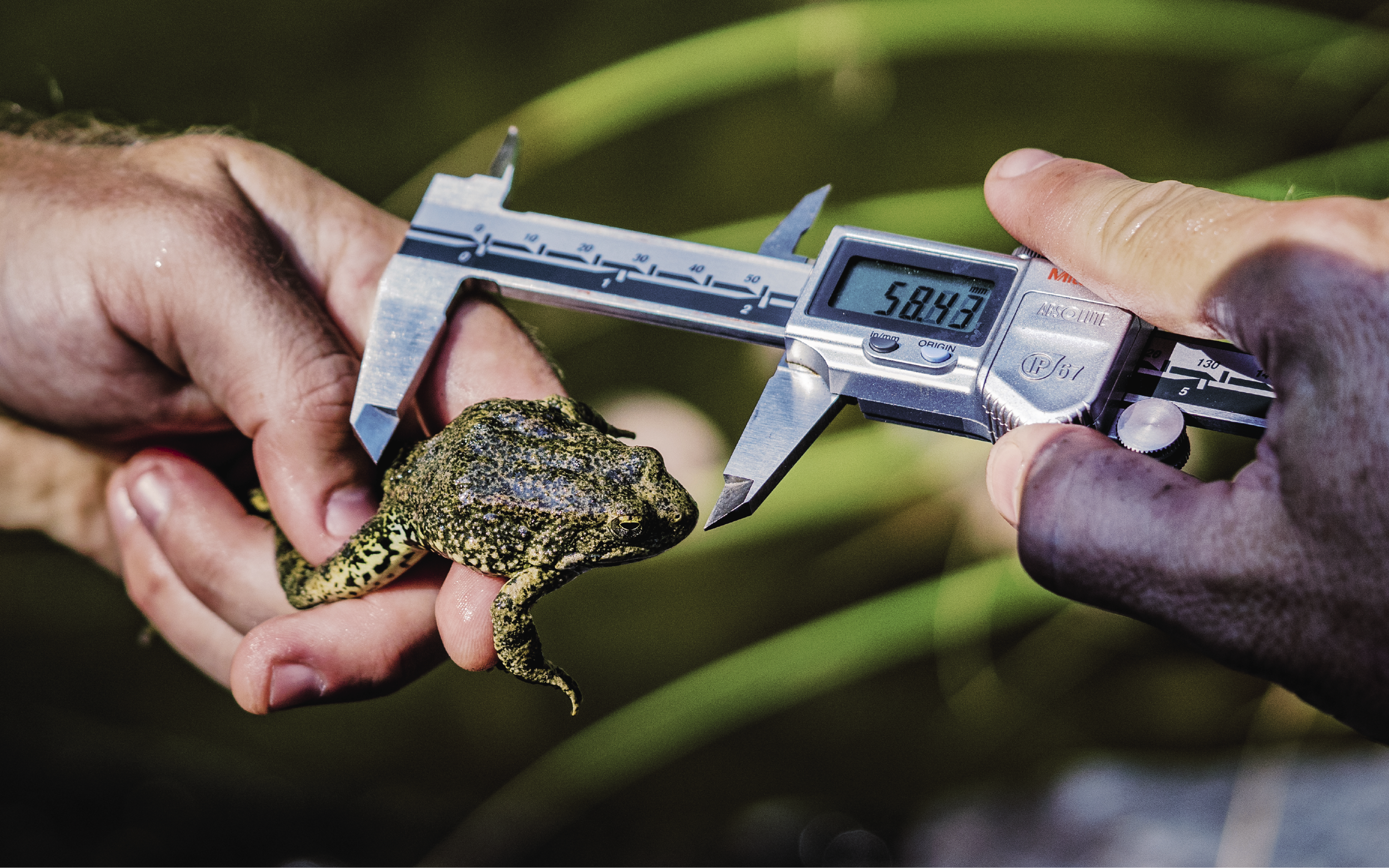 A frog being measured at the North Fork of the American River, a habitat of foothill yellow-legged frogs in Colfax, CA.
A frog being measured at the North Fork of the American River, a habitat of foothill yellow-legged frogs in Colfax, CA.
These models presented scientists with a new understanding: "The stress from climate change, the level of risk to species and ecosystems, is not uniform across regions; it varies quite a bit," Carroll said. "That was the key finding."
But what gets classified as climate refugia? Bumblebees in Europe and chipmunks in Yosemite are seeking cooler climates at higher elevations. For some scientists, that alone is enough to qualify a mountaintop as a climate refuge. Others disagree. After all, where will those plants and animals go when even those mountaintops become too warm? For Toni Lyn Morelli, a research ecologist with the US Geological Survey's Northeast Climate Adaptation Science Center, refugia are places where the climate will change very slowly, or won't change at all.
Take Devils Postpile National Monument, in a valley in the central Sierra Nevada. Even in the heat of summer, the meadows in the valley remain chilly—as much as 18 degrees cooler than the 10,000-foot peaks around them. A phenomenon called cold-air pooling provides a buffer against heat waves. During the day, as heat rises, cold, moist air settles to the valley bottom. Meanwhile, the steep walls of the monument prevent sunlight from warming that air, so the coolness gets locked in. Across the globe, other refugia form around steep slopes that face the poles—the lack of sunlight means that these areas warm less readily. Deep lakes and coastlines form their own refugia, with some areas absorbing heat while others stay cool.
The harsh reality is that it might not make sense to invest limited resources in protecting environments where species will no longer be able to survive. "There's much, much more work to do than we have resources," Morelli said. That work includes removing invasive species and reducing humans' impact. It might even include moving vulnerable species to refugia.
Assisted migration is not without controversy. Some land managers are concerned that newly introduced species will edge out native species, or that newly established populations will eventually blink out on land they haven't evolved to inhabit. Alexis Mychajliw, a paleoecologist at Middlebury College, points out that plants and animals aren't stationary beings, and during past climate change events, they moved themselves. "The history of most species is movement," Mychajliw said. "When the climate changes, they tend to follow those conditions." The sheer pace of human-caused climate change, plus the barriers posed by roads, fences, and subdivisions, make that natural pattern of movement impossible. So why not give species a hand if we know where they might have a better shot at survival?
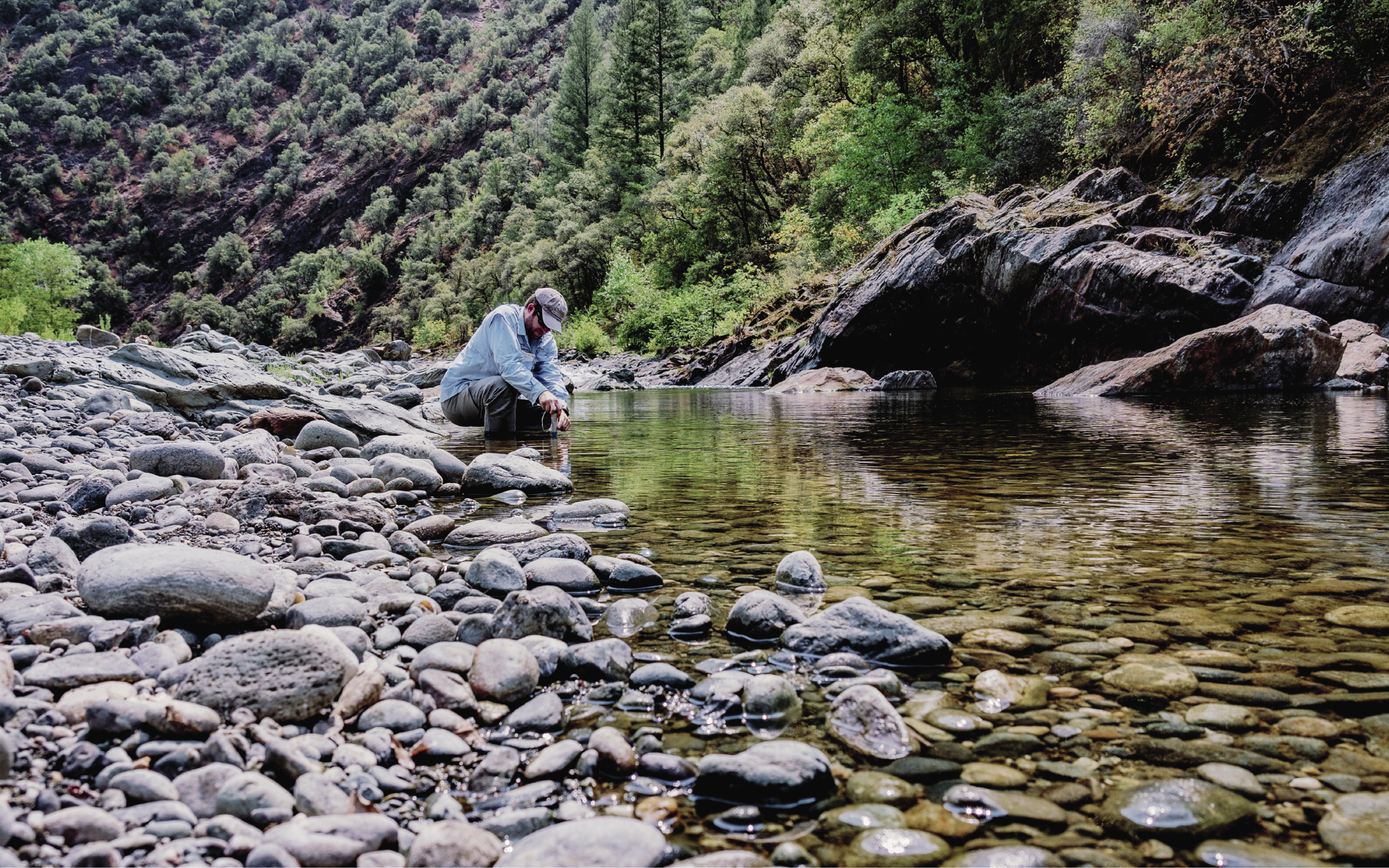 UC Davis ecologist Ryan Peek searches for foothill yellow-legged frogs at North Fork American River in Colfax, CA.
UC Davis ecologist Ryan Peek searches for foothill yellow-legged frogs at North Fork American River in Colfax, CA.
In 2017, ecologists at the National Park Service introduced a cohort of threatened red-legged frogs into Yosemite after identifying areas of the park as likely refugia. The species once lived throughout California but is now limited to pockets across the state. Whether the site of the frogs' introduction was ever a part of their original range is contested, said Andrea Adams, a research scientist at Washington State University, but today, the red-legged frogs are thriving in Yosemite. Adams considers it a conservation success.
It's possible that a similar strategy might save the foothill yellow-legged frog, but first, land managers need to know where the climate refugia are. That's where Claudia Mengelt comes in.
Mengelt, an oceanographer turned land manager, had never heard the term refugia until she stumbled upon Morelli's research while working at the National Academy of Sciences in Washington, DC. Mengelt, who is now the program manager of land management research at the US Geological Survey, was immediately intrigued. Because of the fluid, dynamic nature of ocean environments, marine conservation tends to embrace the inevitability of change and movement, so the idea of climate adaptation felt natural to Mengelt—a fish out of water among frog biologists. By the time she met Morelli in person, Mengelt had moved out West and taken on a new project: developing a conservation plan for the foothill yellow-legged frog.
"I'm like, let's get the two projects together," Mengelt said.
THE DEEPLY RUTTED DIRT ROAD into the Tuolumne River canyon is a series of hairpin turns through sage and dusty shrubs. "This is one of those incomprehensible roads the Forest Service built way back in the day," said Steve Holdeman, a forest aquatic biologist for Stanislaus National Forest. He was driving Mengelt and me down into the canyon to check out some of the sites where Mengelt's team is doing research.
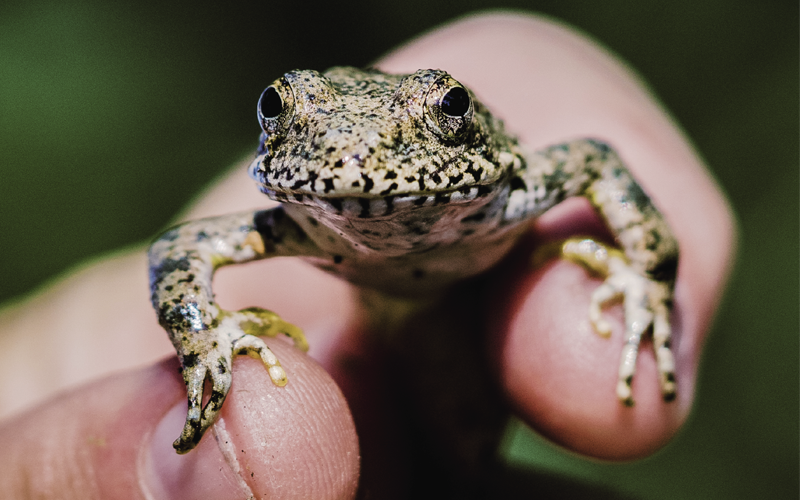 An adult foothill yellow-legged frog at Robbers Ravine in Colfax, CA.
An adult foothill yellow-legged frog at Robbers Ravine in Colfax, CA.
At the bottom of the canyon, we stepped out of the car into blistering heat and air that smelled like campfire smoke. Burned trees lined the hillsides above us. Below, the South Fork of the Tuolumne River wound its way leisurely around rocks and boulders. Just like the pools at Robbers Ravine, the river was thick with algae and white scum. "River snot," Holdeman said. The recently low streamflows weren't strong enough to wash the stuff away. "We're down a couple of inches every year," he added.
While Holdeman isn't directly involved with the refugia mapping initiative, the project's findings could affect the management of Stanislaus National Forest and in turn the work he does with foothill yellow-legged frogs. "Claudia and all those bigger-brained people—they have a more strategic approach," he said in his Tennessee drawl. "I've got the bigger picture on these lands."
A central goal of Mengelt's work is to overcome what she calls the "knowledge to action" barrier. The traditional model of ecology—testing hypotheses, developing conclusions, writing up findings, then going back to the drawing board—is a lengthy process and often fails to present a clear set of actions to policymakers. With climate change, we don't have that kind of time.
"Sometimes the information just describes the problem," Mengelt said. She wants to present land managers at the National Park Service, the Bureau of Land Management, and the US Forest Service with science-based solutions. Together, they could develop decisions based on the data this project generates, even as it evolves.
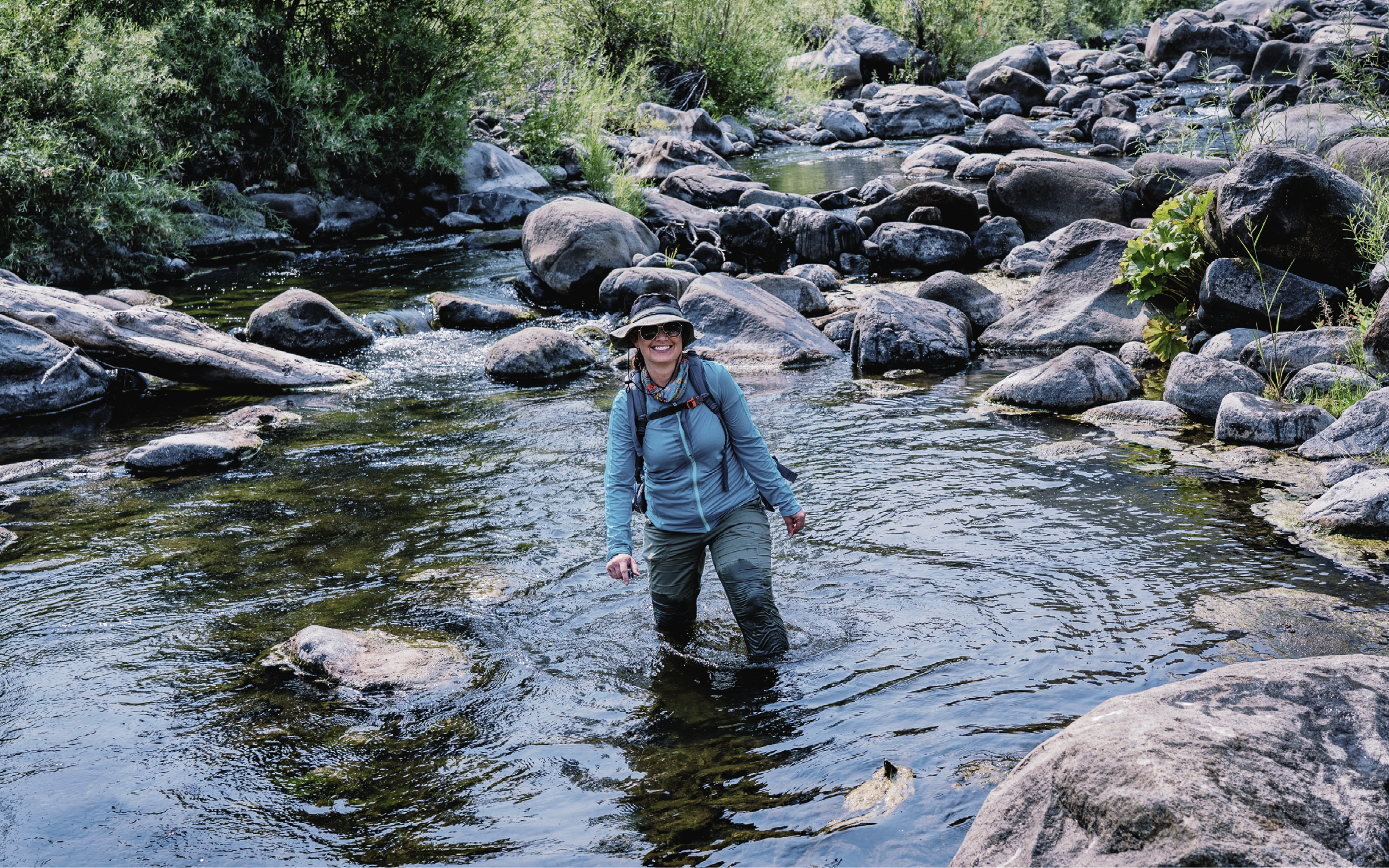 Land manager Claudia Mengelt leads the refugia research searches for foothill yellow-legged frogs at Middle Fork Tuolumne River in Lumsden, CA.
Land manager Claudia Mengelt leads the refugia research searches for foothill yellow-legged frogs at Middle Fork Tuolumne River in Lumsden, CA.
The project is focusing on two river systems: the Tuolumne and the Merced. Both cascade down from the High Sierra through Yosemite before winding their way into the public lands of the Sierra foothills. The work happening at this particular site on the Tuolumne is part of the first prong of Mengelt's project: determining where the frogs are.
That effort is led by Adams. Like Peek, Adams is recording population counts of the frogs she sees, but she's also using a technique that wouldn't have been possible 15 years ago: environmental DNA analysis. Adams is testing water samples for traces of the genetic material left behind by foothill yellow-legged frogs. Meanwhile, a separate team of scientists is working on developing a computer model to identify potential refugia. Tina Mozelewski, a postdoctoral researcher in Morelli's lab at the University of Massachusetts Amherst, is leading that initiative, which involves layering environmental data—such as streamflow and vegetation—on a map alongside population data for the foothill yellow-legged frog. The goal is to determine which variables best predict where frogs live and might be most important for their survival. The scientists will combine the habitat data with previous calculations on the rate of climate change across the landscape, which take into account variables like cold-air pooling. By crunching this data, they can estimate where conditions will change the least over the next 100 years in the Tuolumne and Merced watersheds.
For foothill yellow-legged frogs, refugia will likely be in places where streamflow continues steadily despite drought, said Sarah Yarnell, a hydrologist and river ecologist at UC Davis. They'll likely survive in spring-fed pools—like the one we saw at the top of Robbers Ravine. Springs are fed by aquifers that build up over time as snowmelt and rain leach through cracks in the bedrock. For the time being, the flow from springs is buffered from fluctuations in rainfall or snowmelt. Plus, this water is colder: "Those locations are going to be the most climate buffered because they're not going to be exposed to warming air temperatures," Yarnell said.
We talked about refugia in aquatic environments, and the conversation naturally turned to dams. While the lackadaisical South Fork of the Tuolumne and North Fork of the American are both unregulated by dams, the main stem of the Tuolumne is fragmented by them. It descends from the O'Shaughnessy Dam, which creates the Hetch Hetchy Reservoir higher up in the Sierra, and rushes toward the Don Pedro Dam in the foothills. Every day between 7 A.M. and 11 A.M., O'Shaughnessy Dam releases a pulse of water so thrill-seekers can raft down the turbulent flow. This unnatural rhythm in streamflow isn't ideal for foothill yellow-legged frogs. They're highly attuned to changes in hydrology—the pulse of snowmelt in late spring is their cue to breed. Pulses of water wash egg masses downstream. Plus, the frogs have a hard time migrating around the giant reservoirs created by dams. Isolated in pockets by the dams and unable to live in the cold, deep reservoirs, they've lost the genetic diversity to keep their populations healthy.
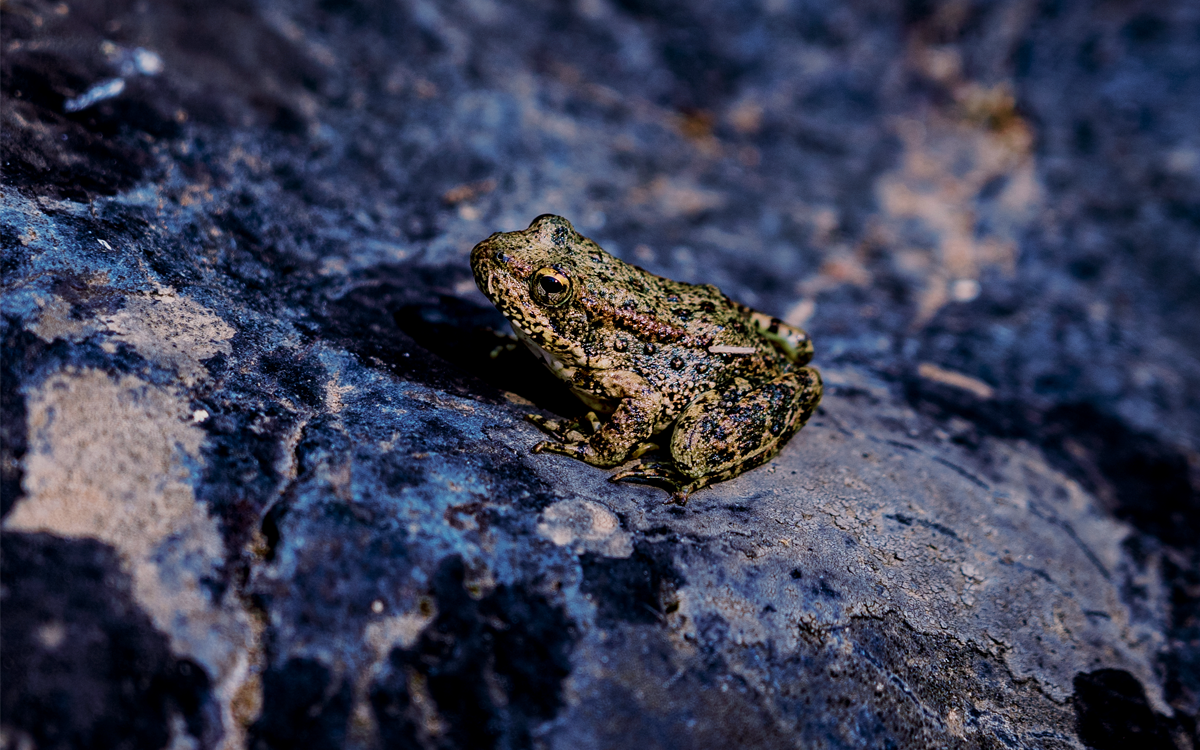 In California, the foothill yellow-legged frog is threatened by climate change. Scientists are working to find it a new home.
In California, the foothill yellow-legged frog is threatened by climate change. Scientists are working to find it a new home.
How these dams will interact with climate change is a major question. Peek suspects that river sites without dams will function as a kind of climate refugia in part because they will allow frogs the mobility to seek more favorable climate conditions on their own and the genetic diversity to withstand changes in their environment. Other researchers wonder if dammed rivers could function as an unnatural climate refugia—dams release water from the bottom of reservoirs, where temperatures remain cold due to lack of sunlight. Plus, the streamflow beneath dams will be somewhat buffered from drought.
Both arms of the foothill yellow-legged frog project—the population data gathering and the refugia mapping—are useful only in tandem. Paired with population data, refugia mapping helps researchers understand which sites will support future conservation efforts, including introductions, and which won't. "When you're talking about reintroductions, that has to be part of the conversation," Adams said. Frog populations that are large and healthy now might serve as sources for future translocation projects—scientists might collect eggs or tadpoles and rear them in a zoo before releasing them at another site. And places that look like refugia might be important sites for those introductions, whether or not foothill yellow-legged frogs ever lived there. "If the goal is to get frogs out on the landscape and save the species, it doesn't really matter," Peek said.
IT'S POSSIBLE that if the climate changes enough, even refugia will reach a sudden tipping point when their regular buffers will no longer function. If, over hundreds of years, snowmelt no longer replenishes underground aquifers, they will eventually empty. Cold-air pooling might not happen in hotter conditions. No refugia will last forever, Morelli said. "I would just say, we don't know if there are tipping points."
During past climate change events, species had more time to evolve traits that would allow them to weather the new conditions. But human-caused climate change is happening at an unprecedented rate—too fast for many species to adapt. Even having just 1,000 extra years would make a big difference. "We need to protect the places where things are moving at a slower rate so that species can do their thing as they have for millions of years," Morelli said. And we might not even need that much time. A recent report from the Intergovernmental Panel on Climate Change found that if we were to significantly reduce carbon emissions, the climate would stabilize within decades.
Not far downstream from where we parked in the Tuolumne River canyon, the South Fork meets the Middle Fork in a deep pool. Holdeman waded in thigh-deep and dunked his head. Mengelt let herself fall backward, fully clothed, into the current so that only her head and feet stuck out. The cold water was a welcome relief from triple-digit temperatures.
Soaking wet, we picked our way back up the South Fork to the car, then trundled up the canyon road. As we climbed the switchbacks, we passed a stream tucked into a fold in the hillside. Holdeman pointed out that all the surface water had long dried up—this stream was likely fed by groundwater. "These little tiny things are incredibly important refuge habitats for the frogs," Holdeman said.
He was reminded of the time when he and Adams had climbed to a waterfall that cascaded down a sheer rock face. At the top, they were confronted by an unlikely sight: a foothill yellow-legged frog. "A beautiful golden one," Holdeman said. It had climbed up the 30-foot waterfall in search of better habitat. Here, among the beige shrubbery, the stream stood out, kelly green, lush with ferns and moss—an oasis.
This article appeared in the Summer 2022 quarterly edition with the headline "An Ark for Amphibians."
 The Magazine of The Sierra Club
The Magazine of The Sierra Club



